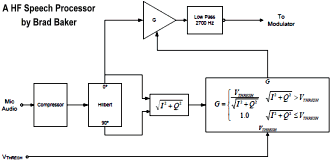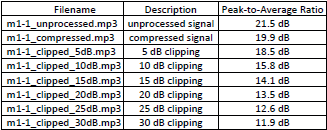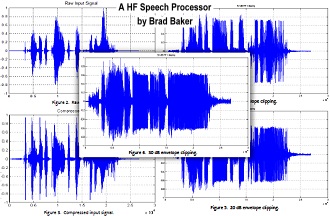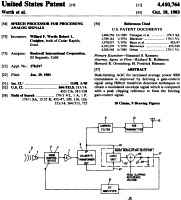High Frequency Speech Processor |
|
RF Cafe visitor and former article contributor Brad Baker* sent a new paper he wrote entitled "High Frequency Speech Processor." In it, he presents a method for clipping of audio (voice) signals at the baseband stage of an RF transmitter in order to facilitate more efficient broadcasting of a single sideband (SSB) signal. Mr. Baker's process applies a Hilbert transform and uses the real part of the complex result to modulate the output. A significant difference between this and previous schemes is that here a feed-forward circuit is used rather than a closed-loop feedback circuit (implemented in software, of course). Brad provided an MP3 audio file which demonstrates various levels of clipping, beginning with a raw, unprocessed sample. You might wonder why he chose the sentence, "It's easy to tell the depth of a well," for use. While I cannot say why (and I didn't ask) that particular one was used, a little research showed that it is a sentence from a list called the Harvard Sentences, From "IEEE Recommended Practice for Speech Quality Measurements." IEEE Transactions on Audio and Electroacoustics, Vol. 17, Issue 3, 225-246, 1969. Revised List of Phonetically Balanced Sentences. Specific phonemes are employed. I suppose you'd have to be a voice processing guy to know about that. Now you know. * See "Tunable Constant Q Band-Pass Filter Design Using q and k Values," by Brad Baker.
In a SSB, HF transmitter, RF clipping of the signal is employed before transmission to decrease the peak-to-average ratio.
High Frequency Speech Processor, by Brad Baker By Brad Baker Title. HF Speech Processor Summary. In a single sideband (SSB) high frequency (HF) transmitter radio frequency (RF) clipping of the signal is employed before transmission to decrease the peak-to-average ratio. This can allow a transmitter to be designed with a lower peak power specification than otherwise. Such a transmitter would have lower power consumption, less heat production and reduced cost. Prior implementations of RF clipping have been at the intermediate frequency (IF), and at baseband using analog processing techniques. The implementation described here is done at baseband, but uses signal processing techniques.
Table 1 - Peak-to-Average Ratios
Voice processing waveforms with various levels of clipping. See PDF document for full-size images.
This MP3 file contains audible examples of clipping levels. Detail. Prior implementations of RF clippers were of two types, intermediate frequency (IF) and baseband. In an IF clipper, the SSB modulated signal was clipped and filtered at the IF frequency of the transmitter before conversion to the RF output frequency for amplification and transmission. In another type, the baseband signal is up converted to an IF (e.g. 455 kHz), converted to SSB, clipped and filtered, and then down converted to the original baseband. This signal would then be used to drive the SSB transmitter. A patent submitted by Werth et al.1 improved on the prior art by using Hilbert transform techniques at baseband to perform RF clipping; no frequency translation was required. It used a novel arrangement of analog multipliers to perform squaring and square root operations with feedback. The current disclosure improves upon the Werth method by performing all processing using feed forward signal processing techniques. Method: The baseband signal is compressed and processed with a Hilbert transformer (Figure 1.). The signal after the Hilbert is complex, but only the real part is used for SSB generation to drive the transmitter. In Figure 1, it is the signal at the input to the variable gain amplifier labeled "VGA." In the Werth patent a feedback loop was used to control the gain of both the I and Q signals. The current method uses a feed-forward technique to determine the necessary gain reduction of the I signal only. The magnitude is calculated and compared to the clipping threshold. If the magnitude is less than or equal to VTHRESH, then the gain is set to 1.0 and no reduction of the I signal is performed. If the magnitude is greater than the threshold, then the gain of the VGA is reduced by an amount sufficient to clamp the calculated magnitude at the threshold value. Following the VGA, a baseband filter is used to suppress out-of-band baseband distortion products.
Posted January 16, 2023 |




